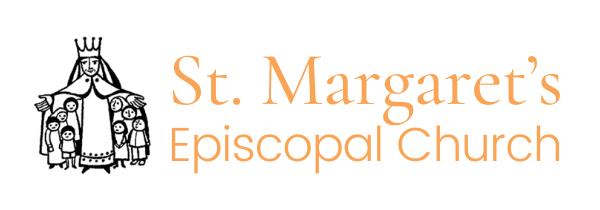
Liturgy at St. Margaret’s
A Breakdown of the Eucharist
The Eucharist (a Greek word for Thanksgiving) is a drama—an invitation to journey into the sacred presence of God. And so worship begins with a Procession. God wants us to open our hearts and minds to the Holy Spirit’s power, and to embrace the chance to be changed.
Worship continues with two Collects and a Song of Praise. A Collect is an ancient form of prayer that, in a sense, “collects” the thoughts and intentions of those gathered into a single whole. It’s meant to unify us, and it helps to direct our spirits to what God desires to teach us that day.
After the Collect of the Day, we hear from Scripture. Typically, this includes readings from the Old Testament, a Psalm, an Epistle, and, finally, one of the Gospels (the stories we have about Jesus). The Gospel comes last not because it’s more important, but because of what the Eucharist is, an act of worship rooted in the life, death, and resurrection of Jesus Christ.
After a sermon, we say together the Nicene Creed, a statement of Christian belief that is more than 1,600 years old. Then, to prepare our hearts for communion, we pray for ourselves and others, as well as confess our sins to God.
Worship then continues with an Offertory, where we return to God those gifts we’ve first been given—our resources, the bread and wine we will use in the sacred meal, and, most critically, ourselves.
After the offertory, there is a Eucharistic Prayer, where together we both remember the final meal Jesus shared with his disciples as well as anticipate the meal we will someday share with Jesus in his Kingdom. The Book of Common Prayer also calls the Eucharist a Sacrifice of Praise and Thanksgiving, since we offer our gratitude to the one who died for us, and who graciously enables us to die to ourselves and live for him. Anglicans believe that the living Jesus really is present in the bread and the wine that we share together, and that the Eucharist is a Sacrament—an outward and visible sign of an inward and spiritual grace.
After we share in the Eucharist, the people are dismissed. It’s like the procession, but in reverse. The people have offered themselves up in worship, only to receive back the immeasurable goodness and grace of God. Which means we can go out into the world with a renewed sense of who we really are and what God is really calling us to do.
A Note on Liturgical Worship
Our worship is liturgical—in accordance with the Book of Common Prayer—and so reflects the earliest practices of the Church. We use set prayers, many of which change during the course of the year. At its best, liturgical worship is counter-cultural, since it binds and forms not only those gathered together, but is also an expression of the whole Church, around the world and across time. Our worship normally begins with Scripture readings and a sermon, culminating in the celebration of the Eucharist, also called communion or the Lord’s Supper.
Liturgy is powerful in part because it enables reflection on the forces that make us who we are. We are always being shaped by the forces that surround us. The only question is what it is that happens to be shaping us—whether it’s the Church, the communities we are a part of, or the culture that is all around. Good liturgy is therefore formative, training Christians to think, love, and worship in a way that both opens our hearts to the Spirit and brings glory to God.
